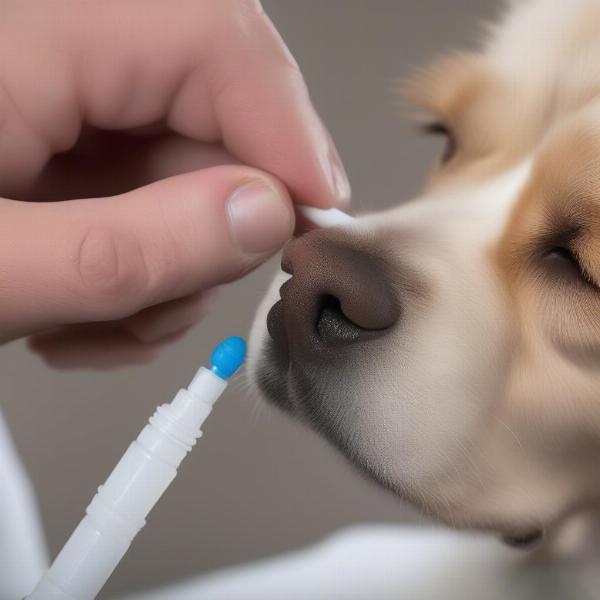Dermotic ear drops are a common treatment option for dog ear infections. Understanding how they work, when they’re appropriate, and how to administer them correctly is crucial for every dog owner. This guide will delve into the details of using dermotic ear drops for dogs, offering practical advice and expert insights to help you navigate ear infections and ensure your furry friend’s comfort.
Understanding Dermotic Ear Drops
Dermotic ear drops are a combination medication typically containing a glucocorticoid (like dexamethasone or hydrocortisone) to reduce inflammation and an antibiotic (like gentamicin or neomycin) to combat bacterial infections. They are often prescribed for otitis externa, the most common type of ear infection in dogs. The drops work by directly targeting the affected area, reducing swelling, itching, and pain, while simultaneously eliminating the bacterial overgrowth contributing to the infection.
 Applying Dermotic Ear Drops to a Dog
Applying Dermotic Ear Drops to a Dog
When Are Dermotic Ear Drops Necessary?
While dermotic ear drops can be effective, they aren’t always necessary. It’s vital to consult with a veterinarian before using any medication on your dog. Symptoms of an ear infection can include redness, swelling, discharge, head shaking, scratching at the ears, and an unpleasant odor. Your vet will diagnose the specific type of infection and determine the best course of treatment. Self-treating can be risky and may worsen the condition or mask underlying issues.
How to Administer Dermotic Ear Drops
Administering ear drops correctly is essential for their effectiveness. First, clean your dog’s ears with a veterinarian-approved ear cleaner. Then, gently pull back the ear flap to expose the ear canal. Hold the dropper close to the canal opening, but avoid touching it to prevent contamination. Squeeze the prescribed number of drops into the ear canal. Gently massage the base of the ear to distribute the medication. Your vet will demonstrate the correct technique and provide specific instructions regarding dosage and frequency.
Potential Side Effects and Precautions
While generally safe, dermotic ear drops can have potential side effects, including temporary hearing loss, irritation, or allergic reactions. It’s crucial to observe your dog for any unusual signs and report them to your vet immediately. Never use dermotic ear drops if your dog’s eardrum is ruptured, as this can cause further complications. Always inform your vet about any other medications your dog is taking to avoid potential drug interactions.
Alternative Treatments and Preventative Measures
Depending on the cause and severity of the ear infection, alternative treatments may be considered, such as antifungal medications or oral antibiotics. Preventative measures can also help minimize the risk of future infections. These include regular ear cleaning, keeping the ears dry, and addressing underlying allergies or other contributing factors.
Conclusion
Dermotic ear drops can be an effective tool in managing dog ear infections. However, proper diagnosis, correct administration, and vigilant monitoring are crucial for successful treatment. Always consult your veterinarian for guidance and address any concerns promptly. By understanding the appropriate use and potential risks associated with dermotic ear drops, you can help keep your canine companion’s ears healthy and comfortable.
FAQ
- How long does it take for dermotic ear drops to work? You should start to see improvement within a few days, but complete the entire course of treatment as prescribed by your vet.
- Can I use human ear drops on my dog? No, never use human ear drops on your dog. They may contain ingredients that are toxic to dogs.
- What if my dog shakes his head after applying the drops? This is normal. Try to distract your dog for a few minutes after application.
- How often should I clean my dog’s ears? Ask your veterinarian for recommendations based on your dog’s breed and individual needs.
- Can diet affect ear infections? Yes, food allergies can contribute to ear infections. Your vet can help you identify potential food allergens.
- Are certain breeds more prone to ear infections? Yes, dogs with floppy ears or hairy ear canals are more susceptible.
- What should I do if the infection doesn’t clear up? Contact your veterinarian. They may need to adjust the treatment plan.
ILM Dog is your trusted resource for expert advice on dog care, breed selection, health, training, nutrition, grooming, and more. We’re committed to providing practical and reliable information to dog owners worldwide. Whether you’re a new pet parent or a seasoned dog lover, ILM Dog offers valuable insights to help you navigate every aspect of dog ownership. Contact us at [email protected] or +44 20-3965-8624. Visit ILM Dog for more information.